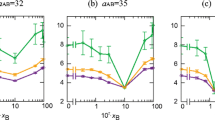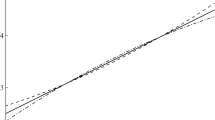Abstract
The mechanism of the phase separation of polymer blends in the presence of a static electric field was investigated using the molecular dynamics with a modified coarse-grained polarizable model. Two electric field effects, i.e., the promotion and hindrance of the phase separation, were found in the system of the upper critical solution temperature (UCST) by varying the dielectric properties of polymer components. Our simulation directly demonstrated that the electric field effects originate from the energy changes of intramolecular unit polarization, intermolecular van der Waals (VDW) and Coulomb interactions induced by the external electric field. The relationship of the energy change and the dielectric constant for the system under electric field is obtained. The interface orientation under electric field was found to happen even before the transition point of phase separation. By assuming that the relative order parameter of the phase separation undergoes the same fluctuations for a system with and without an electric field, the transition temperature under an electric field can be predicted, and quantitative consistency with simulations is obtained.
Similar content being viewed by others
Change history
31 December 2022
An Erratum to this paper has been published: https://doi.org/10.1007/s10118-023-2914-6
References
Ruppel, M.; Pester, C. W.; Langner, K. M.; Sevink, G. J. A.; Schoberth, H. G.; Schmidt, K.; Urban, V. S.; Mays, J. W.; Böker, A. Electric field induced selective disordering in lamellar block copolymers. ACS Nano 2013, 7, 3854–3867.
Amundson, K.; Helfand, E.; Davis, D. D.; Quan, X.; Patel, S. S.; Smith, S. D. Effect of an electric field on block copolymer microstructure. Macromolecules 1991, 24, 6546–6548.
Thurn-Albrecht, T.; Schotter, J.; Kästle, G. A.; Emley, N.; Shibauchi, T.; Krusin-Elbaum, L.; Guarini, K.; Black, C. T.; Tuominen, M. T.; Russell, T. P. Ultrahigh-density nanowire arrays grown in self-assembled diblock copolymer templates. Science 2000, 290, 2126–2129.
Chu, B.; Zhou, X.; Ren, K.; Neese, B.; Lin, M.; Wang, Q.; Bauer, F.; Zhang, Q. M. A dielectric polymer with high electric energy density and fast discharge speed. Science 2006, 313, 334–336.
Roy, P.; Gooh Pattader, P. S. Electrohydrodynamic instability: effect of rheological characteristics on the morphological evolution of liquid crystal-polymer interface. Bull. Mater. Sci. 2020, 43, 169.
Debye, P. Spectral width of the critical opalescence due to concentration fluctuations. Phys. Rev. Lett. 1965, 14, 783–784.
Wirtz, D.; Fuller, G. G. Phase transitions induced by electric fields in near-critical polymer solutions. Phys. Rev. Lett. 1993, 71, 2236–2239.
Orzechowski, K. Electric field effect on the upper critical solution temperature. Chem. Phys. 1999, 240, 275–281.
Beaglehole, D. A critical binary liquid in an electric field. J. Chem. Phys. 1981, 74, 5251–5255.
Reich, S.; Gordon, J. M. Electric field dependence of lower critical phase separation behavior in polymer-polymer mixtures. Polym. Sci., Part B: Polym. Phys. 1979, 17, 371–378.
Kriisa, A.; Roth, C. B. Electric fields enhance miscibility of polystyrene/poly(vinyl methyl ether) blends. J. Chem. Phys. 2014, 141, 134908.
Lee, J. S.; Prabu, A. A.; Kim, K. J.; Park, C. Phase separation and crystallization behavior of poly(vinylidene fluoride)/poly(1,4-butylene adipate) blends under an electric field. Macromolecules 2008, 41, 3598–3604.
Lee, J. S.; Prabu, A. A.; Kim, K. J. UCST-type phase separation and crystallization behavior in poly(vinylidene fluoride)/poly(methyl methacrylate) blends under an external electric field. Macromolecules 2009, 42, 5660–5669.
Schoberth, H. G.; Schmidt, K.; Schindler, K. A.; Böker, A. Shifting the order-disorder transition temperature of block copolymer systems with electric fields. Macromolecules 2009, 42, 3433–3436.
Early, M. D. Dielectric constant measurements near the critical point of cyclohexane-aniline. J. Chem. Phys. 1992, 96, 641–647.
Onuki, A.; Doi, M. Electric birefringence and dichroism in critical binary mixtures. EPL 1992, 17, 63–68.
Onuki, A. Electric-field effects in fluids near the critical point. EPL 1995, 29, 611–616.
Debye, P.; Gravatt, C. C.; Ieda, M. Electric field effect on the critical opalescence. II. Relaxation times of concentration fluctuations. J. Chem. Phys. 1967, 46, 2352–2356.
Martin, J. M.; Delaney, K. T.; Fredrickson, G. H. Effect of an electric field on the stability of binary dielectric fluid mixtures. J. Chem. Phys. 2020, 152, 234901.
Tsori, Y.; Tournilhac, F.; Leibler, L. Demixing in simple fluids induced by electric field gradients. Nature 2004, 430, 544–547.
Reich, S.; Cohen, Y. Phase separation of polymer blends in thin films. J. Polym. Sci., Polym. Phys. Ed. 1981, 19, 1255–1267.
Katsir, Y.; Tsori, Y. Recent advances in liquid mixtures in electric fields. J. Phys.: Condens. Matter 2016, 29, 063002.
Orzechowski, K.; Adamczyk, M.; Wolny, A.; Tsori, Y. Shift of the critical mixing temperature in strong electric fields. theory and experiment. J. Phys. Chem. B 2014, 118, 7187–7194.
Xu, T.; Zvelindovsky, A. V.; Sevink, G. J. A.; Gang, O.; Ocko, B.; Zhu, Y.; Gido, S. P.; Russell, T. P. Electric field induced sphere-to-cylinder transition in diblock copolymer thin films. Macromolecules 2004, 37, 6980–6984.
Lyakhova, K. S.; Zvelindovsky, A. V.; Sevink, G. J. A. Kinetic pathways of order-to-order phase transitions in block copolymer films under an electric field. Macromolecules 2006, 39, 3024–3037.
Tsori, Y.; Tournilhac, F.; Andelman, D.; Leibler, L. Structural changes in block copolymers: coupling of electric field and mobile ions. Phys. Rev. Lett. 2003, 90, 145504.
Lin, C.-Y.; Schick, M.; Andelman, D. Structural changes of diblock copolymer melts due to an external electric field: a self-consistent-field theory study. Macromolecules 2005, 38, 5766–5773.
Martin, J. M.; Li, W.; Delaney, K. T.; Fredrickson, G. H. SCFT study of diblock copolymer melts in electric fields: selective stabilization of orthorhombic Fddd network phase. Macromolecules 2018, 51, 3369–3378.
Zhang, Q.; Xu, R.; Kan, D.; He, X. Molecular dynamics simulation of electric-field-induced self-assembly of diblock copolymers. J. Chem. Phys. 2016, 144, 234901.
See Supplemental Material for further simulation details and theoretical derivation.
Sugita, Y.; Okamoto, Y. Replica-exchange molecular dynamics method for protein folding. Chem. Phys. Lett. 1999, 314, 141–151.
Bauer, P.; Hess, B.; Lindahl, E. GROMACS 2022.2. Zenodo: 2022.
Neumann, M. Dipole moment fluctuation formulas in computer simulations of polar systems. Mol. Phys. 1983, 50, 841–858.
Neumann, M.; Steinhauser, O. Computer simulation and the dielectric constant of polarizable polar systems. Chem. Phys. Lett. 1984, 106, 563–569.
Groot, R. D.; Warren, P. B. Dissipative particle dynamics: bridging the gap between atomistic and mesoscopic simulation. J. Chem. Phys. 1997, 107, 4423–4435.
Horsch, M. A.; Zhang, Z.; Iacovella, C. R.; Glotzer, S. C. Hydrodynamics and microphase ordering in block copolymers: are hydrodynamics required for ordered phases with periodicity in more than one dimension. J. Chem. Phys. 2004, 121, 11455–11462.
Marro, J.; Bortz, A. B.; Kalos, M. H.; Lebowitz, J. L. Time evolution of a quenched binary alloy. II. Computer simulation of a three-dimensional model system. Phys. Rev. B 1975, 12, 2000–2011.
Tsori, Y. Colloquium: phase transitions in polymers and liquids in electric fields. Rev. Mod. Phys. 2009, 81, 1471–1494.
Bottcher, C. J. F. Theory of Electric Polarization. Elsevier Scientific Publishing Company: AMSTERDAM, 1973, Vol. 1.
Landau, L. D.; Lifshitz, E. M. Electrodynamics of Continuous Media. Pergamon: Amsterdam, 1984, Vol. 8.
Huggins, M. L. Solutions of long chain compounds. J. Chem. Phys. 1941, 9, 440–440.
Flory, P. J. Thermodynamics of high polymer solutions. J. Chem. Phys. 1941, 9, 660–660.
Bates Frank, S. Polymer-polymer phase behavior. Science 1991, 251, 898–905.
Fredrickson, G. H.; Helfand, E. Fluctuation effects in the theory of microphase separation in block copolymers. J. Chem. Phys. 1987, 87, 697–705.
Kumar, S.; Rosenberg, J. M.; Bouzida, D.; Swendsen, R. H.; Kollman, P. A. The weighted histogram analysis method for free-energy calculations on biomolecules. I. The method. J. Comput. Chem. 1992, 13, 1011–1021.
Gallicchio, E.; Andrec, M.; Felts, A. K.; Levy, R. M. Temperature weighted histogram analysis method, replica exchange, and transition paths. J. Phys. Chem. B 2005, 109, 6722–6731.
Acknowledgments
This work was financially supported by the National Natural Science Foundation of China (No. 91127046).
Author information
Authors and Affiliations
Corresponding author
Additional information
Notes
The authors declare no competing financial interest.
Electronic Supplementary Information
Rights and permissions
About this article
Cite this article
Zhang, Q., He, XH. Phase Separation of Polymer Blends Induced by an External Static Electric Field. Chin J Polym Sci 41, 972–980 (2023). https://doi.org/10.1007/s10118-022-2877-z
Received:
Accepted:
Published:
Issue Date:
DOI: https://doi.org/10.1007/s10118-022-2877-z




